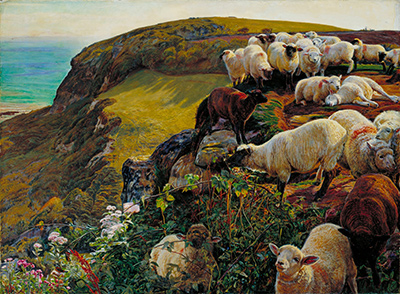Our English Coasts began as a commission for Charles Theobald Maude who wanted a painting of the sheep that he had seen in Hunt's earlier work titled The Hireling Shepherd.
Maude agreed to this painting of sheep on the Sussex clifftops but what seems to be a beautiful yet simple landscape painting hinted at a much more important message.
Our English Coasts was painted between August and December 1852. Hunt painted outside "en plein air" with oils on canvas in order to observe directly from nature. He tolerated poor weather as he painted the cliffs at Fairlight Glen near Hastings, capturing the glorious scene in intricate detail and vivid colours.
He managed to thrill critics with the way he captured the light so beautifully, the realism of the sheep on the cliffs and the minute details of the flora on the clifftops.
The title Our English Coasts and the chosen spot near Hastings hints at one of the themes that Hunt portrayed within this painting. The viewer can see the English Channel in the painting with France so close and almost visible in the background.
The sheep are placed on the edge of the unprotected cliffs demonstrating quite clearly, that the borders of the country were open and totally unprotected. The Normans had conquered England here in 1066 at the battle of Hastings and during 1852, tensions with France were high once more.
Interestingly when the painting was taken to the Universal Exposition in Paris in 1855, Hunt changed the name of the painting to Strayed Sheep. Yet this was also pointing to another meaning, similar to one hinted at in The Hireling Shepherd, whereby the flock had been left unattended without any shepherd on the clifftops and could be seen straying from the path.
Without the guidance from a shepherd, the viewer can see that the sheep are dangerously close to the edge of the steep cliffs and are likely to fall. This social comment was pointed at the Church.
This beautiful depiction of the English Coasts with its deeper meanings can now be seen in the Tate Britain in London.




